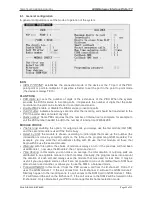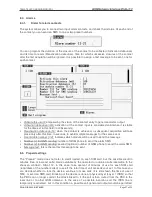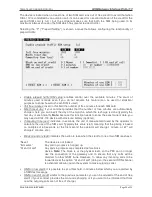
TEMA TELECOMUNICAZIONI SRL
GSM Gateway Interface DIAL-112
MAS-DIAL112-REV06EN
Page 17 of 35
7. SERVICES
7.1. Outbound call gateway
In its basic function, through the urban attack of the PBX connected to DIAL-112, you make
outgoing calls using built-in GSM modules by transforming a call from fixed line to a GSM one. The
service must be explicitly enabled by the "Enable outgoing calls" in the mask of programming
(active by default).
Lifting the handset of the connected ISDN device or engaging DIAL-112 through the PBX, you
heard the DIAL-112 invitation tone to select.
Then, type the phone number to call within the configurable time to select (field mask programming
"Interdigits", default 6 sec.).
DIAL-112 must gather all the digits of the number to call before making the call itself through its
internal GSM module (as it does with a normal GSM phone) using a configurable timeout
("Interdigits", default 6 sec.). So, after the last digit in the composed number, it must pass this
timeout before the call will be generated to the GSM network.
DIAL-112, however, send the call without waiting time for interdigit after receiving a number of
digits (the area of mask programming "Max digits", default 10), unless the number is not preceded
by the international prefix 00, in which case the device always waits for the expiry interdigit time
before making the call (since it can not know the actual length of the number to call). It is possible
to speed up the call of numbers consist of fewer digits simply by pressing the “#” (pound) at the
end of the number to call, to tell DIAL-112 to proceed immediately to connect to GSM network.
While sends the call to the GSM network, DIAL-112 may send the caller a special multitone
reporting to indicate to user that the call is being generated. The user can verify, for each call, the
actual use of DIAL-112 for calls planned. This service is subject to the parameter "Ringing tone": If
you do not want this alert, you can disable it in the form of programming.
After sending the call, DIAL-112 connects your phone to allow the caller to hear reports on the
progress of the call itself (free, busy, etc.).
It is possible to hide the identity of the SIM, simply activating the appropriate field ("Hide caller");
see 8.1 later in the manual. This approach is effective for all calls. Wanting to choose whether or
not to mask the identity of the SIM per-call basis, regardless of the programming of the system, the
GSM network allows the sending of force or masking the CLI using special codes from universal
add to the number called. The codes are:
CLI FORCED FORWARDING
*31# +
GSM NUMBER
CLI FORCED HIDING
#31# +
GSM NUMBER
To keep the modules GSM always available to make outgoing calls, is that it is possible to block
any incoming calls: DIAL-112 will refuse any incoming calls without answering.
If the PBX is equipped with advanced routing (LCR - Least Cost Routing), you can configure the
table (ARS - Automatic Route Select table) so that DIAL-112 is used as a general default output for
direct phone calls from internal PBX phones to one or more mobile telephone line prefixes.
If the PBX does not have the function of LCR, you can set a code selection where the DIAL-112
ISDN attack is linked, before the phone number every time you want to use DIAL-112 as an output
gateway. See the documentation of your PBX for more information on these advanced features.
It is also possible to activate the "Prepaid Traffic” service. In this mode, the system takes no
account of the real credit on the SIM Card (service not offered in a simple and uniform way by the
GSM operators), but count the minutes for outgoing calls (taking advantage of any promotions or
contracts providing for a certain number of free minutes to all or particular numbers).
















































